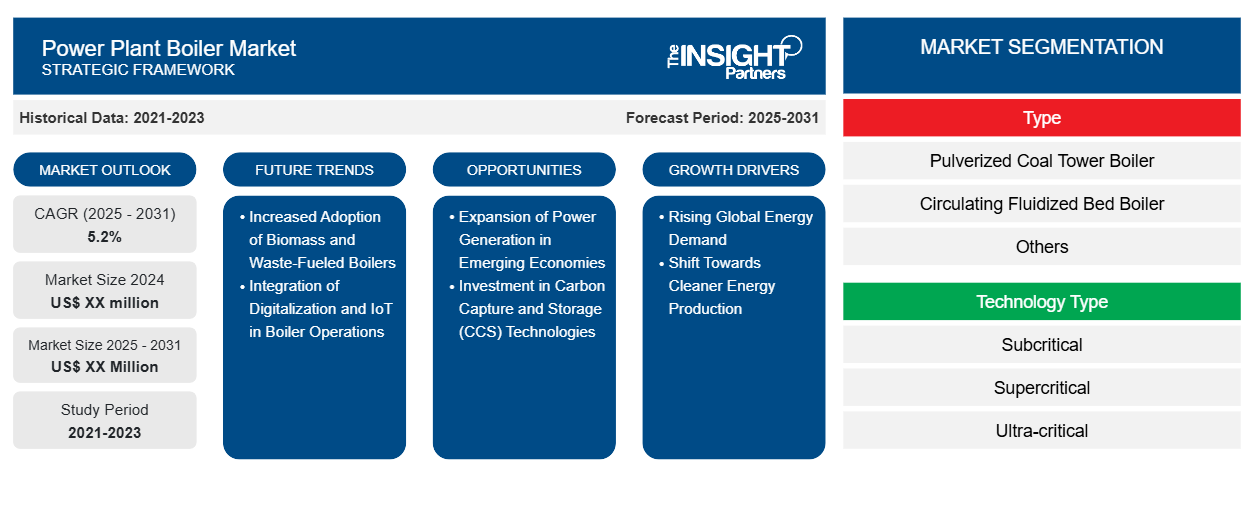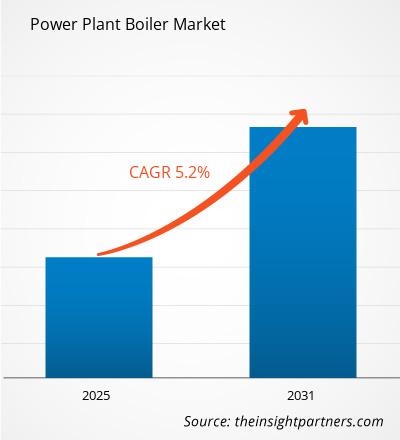Si prevede che il mercato delle caldaie per centrali elettriche registrerà un CAGR del 5,2% dal 2024 al 2031, con una dimensione di mercato in espansione da XX milioni di dollari USA nel 2024 a XX milioni di dollari USA entro il 2031.
Il report è segmentato per tipo (caldaia a torre a carbone polverizzato, caldaia a letto fluido circolante, altri); tipo di tecnologia (subcritica, supercritica, ultracritica); tipo di combustibile (carbone, petrolio, gas naturale, nucleare, rinnovabile). L'analisi globale è ulteriormente suddivisa a livello regionale e nei principali paesi. Il report offre il valore in USD per l'analisi e i segmenti di cui sopra.
Scopo del rapporto
Il report Power Plant Boiler Market di The Insight Partners mira a descrivere il panorama attuale e la crescita futura, i principali fattori trainanti, le sfide e le opportunità. Ciò fornirà spunti a vari stakeholder aziendali, come:
- Fornitori/produttori di tecnologia: per comprendere le dinamiche di mercato in evoluzione e conoscere le potenziali opportunità di crescita, consentendo loro di prendere decisioni strategiche informate.
- Investitori: condurre un'analisi completa delle tendenze in merito al tasso di crescita del mercato, alle proiezioni finanziarie del mercato e alle opportunità esistenti lungo la catena del valore.
- Enti di regolamentazione: regolamentano le politiche e le attività di controllo sul mercato allo scopo di ridurre al minimo gli abusi, preservare la fiducia degli investitori e sostenere l'integrità e la stabilità del mercato.
Segmentazione del mercato delle caldaie per centrali elettriche
Tipo
- Caldaia a torre a carbone polverizzato
- Caldaia a letto fluido circolante
- Altri
Tipo di tecnologia
- Subcritico
- Supercritico
- Ultracritico
Tipo di carburante
- Carbone
- Petrolio
- Gas naturale
- Nucleare
- Rinnovabile
Geografia
- America del Nord
- Europa
- Asia-Pacifico
- America del Sud e Centro
- Medio Oriente e Africa
Personalizza questo report in base alle tue esigenze
Riceverai la personalizzazione gratuita di qualsiasi report, comprese parti di questo report, o analisi a livello nazionale, pacchetto dati Excel, oltre a usufruire di grandi offerte e sconti per start-up e università
- Scopri le principali tendenze di mercato in questo rapporto.Questo campione GRATUITO includerà analisi di dati che spaziano dalle tendenze di mercato alle stime e alle previsioni.
Fattori trainanti della crescita del mercato delle caldaie per centrali elettriche
- Domanda energetica globale in crescita: poiché la domanda energetica mondiale continua a crescere a causa dell'industrializzazione, dell'urbanizzazione e della crescita demografica, le centrali elettriche sono sotto pressione per aumentare la capacità di generazione di elettricità. Le caldaie svolgono un ruolo cruciale nelle centrali elettriche convertendo il combustibile in vapore, che aziona le turbine per generare elettricità. Questa crescente domanda di energia, in particolare nei mercati emergenti, è un fattore chiave per il mercato delle caldaie per centrali elettriche, poiché sono necessarie caldaie nuove e più efficienti per soddisfare questi requisiti.
- Spostamento verso una produzione di energia più pulita: la crescente pressione per ridurre le emissioni di carbonio e mitigare il cambiamento climatico sta spingendo i gestori di centrali elettriche a investire in tecnologie più pulite ed efficienti. Le caldaie moderne, come quelle utilizzate nei sistemi di cogenerazione (CHP) o negli impianti che utilizzano fonti rinnovabili come la biomassa, sono essenziali per questa transizione. Le caldaie dotate di tecnologie di cattura del carbonio e quelle progettate per bruciare combustibili alternativi a basse emissioni stanno contribuendo allo spostamento verso un'energia più pulita, guidando la crescita del mercato.
Tendenze future del mercato delle caldaie per centrali elettriche
- Maggiore adozione di caldaie alimentate a biomassa e rifiuti: c'è una tendenza crescente verso l'uso di caldaie alimentate a biomassa e rifiuti come parte della transizione verso l'energia rinnovabile. Queste caldaie possono convertire materiali organici, come legno, rifiuti agricoli o rifiuti solidi urbani, in energia. Il passaggio a combustibili sostenibili e a zero emissioni di carbonio è guidato da politiche governative, come sussidi per l'energia verde e tasse sul carbonio sui combustibili fossili. Si prevede che questa tendenza continuerà man mano che le nazioni cercheranno di ridurre la loro dipendenza dal carbone e dal gas naturale.
- Integrazione di digitalizzazione e IoT nelle operazioni delle caldaie: l'adozione di tecnologie digitali e Internet of Things (IoT) sta trasformando le operazioni delle caldaie nelle centrali elettriche. Integrando sensori avanzati, sistemi di monitoraggio e tecnologie di manutenzione predittiva, gli operatori delle centrali elettriche possono ottimizzare le prestazioni delle caldaie, ridurre i tempi di fermo e prevenire costosi guasti. I dati in tempo reale consentono un utilizzo più efficiente del carburante, processi di combustione migliorati e una migliore gestione dei rischi operativi, guidando la domanda di caldaie abilitate digitalmente sul mercato.
Opportunità di mercato per le caldaie delle centrali elettriche
- Espansione della generazione di energia nelle economie emergenti: molti paesi in via di sviluppo nell'Asia-Pacifico, nel Medio Oriente e in Africa stanno espandendo rapidamente la loro infrastruttura energetica per soddisfare la crescente domanda di elettricità. Questa espansione presenta opportunità significative per il mercato delle caldaie per centrali elettriche, poiché queste regioni costruiscono nuove centrali elettriche basate su carbone, gas naturale ed energie rinnovabili. La crescente necessità di sistemi di generazione di energia affidabili ed efficienti in queste regioni offre un'ampia gamma di opportunità per produttori e fornitori di caldaie.
- Investimenti in tecnologie di cattura e stoccaggio del carbonio (CCS): con la spinta globale verso la decarbonizzazione, c'è un crescente interesse nelle tecnologie di cattura e stoccaggio del carbonio (CCS) per ridurre le emissioni delle caldaie delle centrali elettriche. Le caldaie dotate di sistemi CCS catturano le emissioni di CO2 durante la combustione e le immagazzinano sottoterra o le riutilizzano per uso industriale. Questo è un mercato emergente per le caldaie delle centrali elettriche, che offre alle aziende opportunità di innovare e sviluppare caldaie integrate CCS più efficienti da utilizzare sia nelle centrali elettriche nuove che in quelle esistenti.
Approfondimenti regionali sul mercato delle caldaie per centrali elettriche
Le tendenze regionali e i fattori che influenzano il Power Plant Boiler Market durante il periodo di previsione sono stati ampiamente spiegati dagli analisti di Insight Partners. Questa sezione discute anche i segmenti e la geografia del Power Plant Boiler Market in Nord America, Europa, Asia Pacifico, Medio Oriente e Africa, e Sud e Centro America.

- Ottieni i dati specifici regionali per il mercato delle caldaie per centrali elettriche
Ambito del rapporto sul mercato delle caldaie per centrali elettriche
| Attributo del report | Dettagli |
|---|---|
| Dimensioni del mercato nel 2024 | XX milioni di dollari USA |
| Dimensioni del mercato entro il 2031 | XX milioni di dollari USA |
| CAGR globale (2025 - 2031) | 5,2% |
| Dati storici | 2021-2023 |
| Periodo di previsione | 2025-2031 |
| Segmenti coperti | Per tipo
|
| Regioni e Paesi coperti | America del Nord
|
| Leader di mercato e profili aziendali chiave |
|
Densità dei player del mercato delle caldaie per centrali elettriche: comprendere il suo impatto sulle dinamiche aziendali
Il mercato delle caldaie per centrali elettriche sta crescendo rapidamente, spinto dalla crescente domanda degli utenti finali dovuta a fattori quali l'evoluzione delle preferenze dei consumatori, i progressi tecnologici e una maggiore consapevolezza dei vantaggi del prodotto. Con l'aumento della domanda, le aziende stanno ampliando le loro offerte, innovando per soddisfare le esigenze dei consumatori e capitalizzando sulle tendenze emergenti, il che alimenta ulteriormente la crescita del mercato.
La densità degli operatori di mercato si riferisce alla distribuzione di aziende o società che operano in un particolare mercato o settore. Indica quanti concorrenti (operatori di mercato) sono presenti in un dato spazio di mercato in relazione alle sue dimensioni o al valore di mercato totale.
Le principali aziende che operano nel mercato delle caldaie per centrali elettriche sono:
- Babcock e Wilcox Enterprises, Inc.
- Bharat Heavy Electricals Limited (BHEL)
- Dongfang Electric Corporation Limited (DEC Ltd)
- Doosan Heavy Industries e Costruzioni
- Compagnia elettrica generale
Disclaimer : le aziende elencate sopra non sono classificate secondo un ordine particolare.

- Ottieni una panoramica dei principali attori del mercato delle caldaie per centrali elettriche
Punti chiave di vendita
- Copertura completa: il rapporto copre in modo completo l'analisi di prodotti, servizi, tipologie e utenti finali del mercato delle caldaie per centrali elettriche, fornendo una panoramica olistica.
- Analisi degli esperti: il rapporto è compilato sulla base della conoscenza approfondita di esperti e analisti del settore.
- Informazioni aggiornate: il rapporto garantisce la pertinenza aziendale grazie alla copertura di informazioni recenti e tendenze nei dati.
- Opzioni di personalizzazione: questo report può essere personalizzato per soddisfare le esigenze specifiche del cliente e adattarsi in modo appropriato alle strategie aziendali.
Il rapporto di ricerca sul mercato delle caldaie per centrali elettriche può, quindi, aiutare a guidare il percorso di decodificazione e comprensione dello scenario del settore e delle prospettive di crescita. Sebbene possano esserci alcune preoccupazioni valide, i vantaggi complessivi di questo rapporto tendono a superare gli svantaggi.
- Analisi storica (2 anni), anno base, previsione (7 anni) con CAGR
- Analisi PEST e SWOT
- Valore/volume delle dimensioni del mercato - Globale, regionale, nazionale
- Industria e panorama competitivo
- Set di dati Excel
- Workwear Market
- Gas Engine Market
- Environmental Consulting Service Market
- Fill Finish Manufacturing Market
- Constipation Treatment Market
- Electronic Toll Collection System Market
- Electronic Signature Software Market
- Data Center Cooling Market
- Medical Second Opinion Market
- Aircraft Wire and Cable Market

Report Coverage
Revenue forecast, Company Analysis, Industry landscape, Growth factors, and Trends

Segment Covered
This text is related
to segments covered.

Regional Scope
North America, Europe, Asia Pacific, Middle East & Africa, South & Central America

Country Scope
This text is related
to country scope.
Domande frequenti
Some of the customization options available based on the request are an additional 3-5 company profiles and country-specific analysis of 3-5 countries of your choice. Customizations are to be requested/discussed before making final order confirmation, as our team would review the same and check the feasibility.
The report can be delivered in PDF/PPT format; we can also share excel dataset based on the request.
The leading players operating in the Power Plant Boiler Market include Babcock & Wilcox Enterprises, Inc., Harbin Electric Corporation, Alstom, General Electric, Dongfang Boiler Group Co., Ltd., Zhengzhou Boiler Co., Ltd, Doosan Heavy Industries & Construction
Growing development of industrial sectoris the key future trend of the Power Plant Boiler Market
The Power Plant Boiler Market is estimated to witness a CAGR of 5.2% from 2023 to 2031
The major factors driving the Power Plant Boiler Market are: Rise in development of oil and gas sector and the growth of power generation sector
Trends and growth analysis reports related to Energy and Power : READ MORE..
1.Babcock and Wilcox Enterprises, Inc.
2.Bharat Heavy Electricals Limited (BHEL)
3.Dongfang Electric Corporation Limited (DEC Ltd)
4.Doosan Heavy Industries and Construction
5.General Electric Company
6.Harbin Electric Corporation Co., Ltd
7.IHI Corporation
8.Mitsubishi Heavy Industries, Ltd.
9.Siemens AG
10.Thermax Limited
The Insight Partners performs research in 4 major stages: Data Collection & Secondary Research, Primary Research, Data Analysis and Data Triangulation & Final Review.
- Data Collection and Secondary Research:
As a market research and consulting firm operating from a decade, we have published and advised several client across the globe. First step for any study will start with an assessment of currently available data and insights from existing reports. Further, historical and current market information is collected from Investor Presentations, Annual Reports, SEC Filings, etc., and other information related to company’s performance and market positioning are gathered from Paid Databases (Factiva, Hoovers, and Reuters) and various other publications available in public domain.
Several associations trade associates, technical forums, institutes, societies and organization are accessed to gain technical as well as market related insights through their publications such as research papers, blogs and press releases related to the studies are referred to get cues about the market. Further, white papers, journals, magazines, and other news articles published in last 3 years are scrutinized and analyzed to understand the current market trends.
- Primary Research:
The primarily interview analysis comprise of data obtained from industry participants interview and answers to survey questions gathered by in-house primary team.
For primary research, interviews are conducted with industry experts/CEOs/Marketing Managers/VPs/Subject Matter Experts from both demand and supply side to get a 360-degree view of the market. The primary team conducts several interviews based on the complexity of the markets to understand the various market trends and dynamics which makes research more credible and precise.
A typical research interview fulfils the following functions:
- Provides first-hand information on the market size, market trends, growth trends, competitive landscape, and outlook
- Validates and strengthens in-house secondary research findings
- Develops the analysis team’s expertise and market understanding
Primary research involves email interactions and telephone interviews for each market, category, segment, and sub-segment across geographies. The participants who typically take part in such a process include, but are not limited to:
- Industry participants: VPs, business development managers, market intelligence managers and national sales managers
- Outside experts: Valuation experts, research analysts and key opinion leaders specializing in the electronics and semiconductor industry.
Below is the breakup of our primary respondents by company, designation, and region:

Once we receive the confirmation from primary research sources or primary respondents, we finalize the base year market estimation and forecast the data as per the macroeconomic and microeconomic factors assessed during data collection.
- Data Analysis:
Once data is validated through both secondary as well as primary respondents, we finalize the market estimations by hypothesis formulation and factor analysis at regional and country level.
- Macro-Economic Factor Analysis:
We analyse macroeconomic indicators such the gross domestic product (GDP), increase in the demand for goods and services across industries, technological advancement, regional economic growth, governmental policies, the influence of COVID-19, PEST analysis, and other aspects. This analysis aids in setting benchmarks for various nations/regions and approximating market splits. Additionally, the general trend of the aforementioned components aid in determining the market's development possibilities.
- Country Level Data:
Various factors that are especially aligned to the country are taken into account to determine the market size for a certain area and country, including the presence of vendors, such as headquarters and offices, the country's GDP, demand patterns, and industry growth. To comprehend the market dynamics for the nation, a number of growth variables, inhibitors, application areas, and current market trends are researched. The aforementioned elements aid in determining the country's overall market's growth potential.
- Company Profile:
The “Table of Contents” is formulated by listing and analyzing more than 25 - 30 companies operating in the market ecosystem across geographies. However, we profile only 10 companies as a standard practice in our syndicate reports. These 10 companies comprise leading, emerging, and regional players. Nonetheless, our analysis is not restricted to the 10 listed companies, we also analyze other companies present in the market to develop a holistic view and understand the prevailing trends. The “Company Profiles” section in the report covers key facts, business description, products & services, financial information, SWOT analysis, and key developments. The financial information presented is extracted from the annual reports and official documents of the publicly listed companies. Upon collecting the information for the sections of respective companies, we verify them via various primary sources and then compile the data in respective company profiles. The company level information helps us in deriving the base number as well as in forecasting the market size.
- Developing Base Number:
Aggregation of sales statistics (2020-2022) and macro-economic factor, and other secondary and primary research insights are utilized to arrive at base number and related market shares for 2022. The data gaps are identified in this step and relevant market data is analyzed, collected from paid primary interviews or databases. On finalizing the base year market size, forecasts are developed on the basis of macro-economic, industry and market growth factors and company level analysis.
- Data Triangulation and Final Review:
The market findings and base year market size calculations are validated from supply as well as demand side. Demand side validations are based on macro-economic factor analysis and benchmarks for respective regions and countries. In case of supply side validations, revenues of major companies are estimated (in case not available) based on industry benchmark, approximate number of employees, product portfolio, and primary interviews revenues are gathered. Further revenue from target product/service segment is assessed to avoid overshooting of market statistics. In case of heavy deviations between supply and demand side values, all thes steps are repeated to achieve synchronization.
We follow an iterative model, wherein we share our research findings with Subject Matter Experts (SME’s) and Key Opinion Leaders (KOLs) until consensus view of the market is not formulated – this model negates any drastic deviation in the opinions of experts. Only validated and universally acceptable research findings are quoted in our reports.
We have important check points that we use to validate our research findings – which we call – data triangulation, where we validate the information, we generate from secondary sources with primary interviews and then we re-validate with our internal data bases and Subject matter experts. This comprehensive model enables us to deliver high quality, reliable data in shortest possible time.




 Get Free Sample For
Get Free Sample For